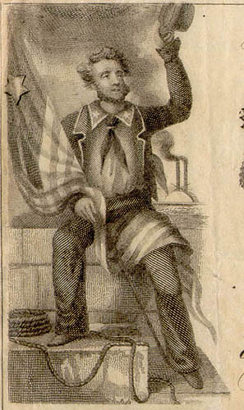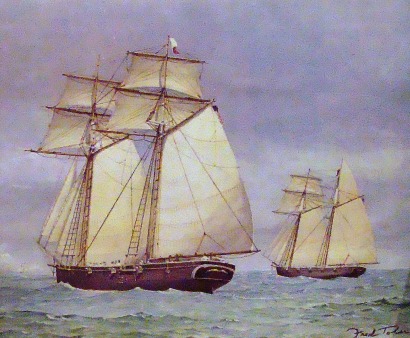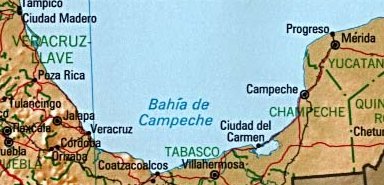|
|
In
the spring of 1840, the Navy of the Republic of Texas was immersed in a political
battle between President Mirabeau Lamar and his arch-enemy, former president Sam
Houston, currently serving as a member of the Texas Congress. The Congress,
led by Houston, had already
dismantled the Texas Army in an effort to curtail Lamar’s free-spending, expansionist
policies, and now they were set on dealing with the Texas Navy in the same manner.
Into the midst of this acrimonious struggle, stepped a 28-year-old naval first
lieutenant, Edwin Ward Moore, fluent in Spanish, and with 12 years experience
in the American Navy.
In 1838, a United States squadron of warships, including
Edwin Moore’s sloop-of-war Boston, anchored in Galveston Bay. Lieutenant
Moore, whose brother already resided in Texas, became
intrigued with the efforts of the new Republic to start a navy from scratch. Since
prospects for promotion were dim at best in the U.S. Navy of the day, which was
both small and out-of-date, Moore decided to take a risk and offer his services
to the Republic of Texas. In 1839, he resigned his American naval commission and
accepted an appointment as commodore of the new Texas fleet. The majority of the
other officers who served in the fleet were also recruited from the U.S. Navy. |
 |
Naval
Scene from Republic
Texas 1838 Currency
Wikimedia Commons |
The first task for
the newly promoted Commodore Moore and his officers was to enlist the sailors
and marines required to man the fleet. To accomplish this task, Moore traveled
to New York, where he set up a recruiting office at the Brooklyn Navy Yard, offering
both adventure and prize money for all men who joined the Texas
cause. He soon had the seamen he required, only to return to Texas
and be caught up in the squabble between Lamar and Houston.
However, Moore could plainly see that Lamar’s proposed mission to Mexico had public
support, and being unfamiliar with the highly partisan politics of the Republic,
he disregarded the strong opposition to his plans by the Houston
faction.
Eager
to apply pressure to the ongoing secret negotiations between Texas
and Mexico, Commodore Moore set sail in June 1840, on the flagship Austin,
accompanied by the steamship Zavala and three schooners. Moore had little
faith in the peace negotiations, and he was determined to deal a blow to Mexico
that would bring the Mexicans to heel and force them to recognize the independence
of Texas. In support of this goal, he established
a blockade of the Mexican coast off the port of Tampico, stopping all incoming
and outgoing ships.
By
fall, it was obvious that the peace negotiations had failed, and with the fleet
desperately low on food and fuel, Moore was forced to choose between taking action
and sailing home. He chose action, sailing the Austin, the Zavala,
and the San Bernard ninety miles up the Tabasco River to the provincial
capital of San Juan Bautista, where he negotiated a deal with the Yucatan rebels,
who were locked in a struggle with the Mexican government for their own independence.
The agreement called for Moore to assist the rebels in capturing the capital in
exchange for $25,000, but when the city fell without a shot being fired, the Texans
had to seize two rebel ships and hold them for ransom before receiving their money.
The fleet sailed for Texas in January 1841. |
 |
San
Bernard (left) and San Jacinto (right) Schooners-of-war
Photo courtesy Ken
Rudine, March 2010 |
Zavala
(left) and San Antonio(right) Schooners-of-war
Photo courtesy Ken
Rudine, March 2010 |
Upon his return to
Galveston,
Commodore Moore was greeted with the news that Great Britain had formally recognized
the Republic of Texas. Moore wanted to return to sea immediately and continue
to pressure Mexico, but during a brief meeting with Lamar, the President decided
it would be best to wait and allow Britain to try and negotiate a settlement between
Mexico and Texas. However, instead of laying up his
ships for repair and discharging most of his seamen as Lamar had first suggested,
Moore persuaded the President to keep the Navy busy by conducting a survey of
the Texas coast. The survey
was a complete success, resulting in the first accurate navigation charts of the
Gulf of Mexico. With the use of the new charts, shipping losses dropped dramatically
and insurance rates fell, providing a boost to the Texas
economy.
Meanwhile,
Mexico had broken off negotiations, and President Lamar and his Secretary of State,
Samuel A. Roberts, had become disenchanted with the prospects for peace with the
government of Santa Anna. As a result, Lamar launched his ill-fated expedition
to Santa Fe and entered into secret negotiations with Yucatan to form an alliance
against Mexico. In 1838, an insurrection had begun in Yucatan. The rebels were
deeply dissatisfied with the dictatorial methods of Santa Anna, and in 1840 the
local assembly, like its new Texas ally, had declared
independence and drafted a constitution based on the Mexican Constitution of 1824.
In September 1841, a deal was struck between Yucatan and Texas,
whereby Yucatan agreed to pay Texas $8000 a month
for the use of three ships to defend its coastline against Mexican raiding. All
proceeds from any prize ships taken in the operation would be split. Commodore
Moore was given command, with orders to capture Mexican towns and demand ransom
payments for their return. In order to enforce payment, Moore was authorized to
destroy public works and seize public property. However, speed was of the essence
if the operation was to be implemented. Sam
Houston had just been reelected President of the Republic, and Lamar and Moore
feared that, if given the opportunity, he would cancel the agreement with Yucatan
as soon as he took office.
On December 15, two days after being sworn
in as President of the Republic, Sam
Houston issued an order canceling the Yucatan operation, but the order arrived
too late. The Austin, the San Antonio, and the San Bernard
had already set sail for Sisal, Yucatan. Commodore Moore was fully aware that
his mission did not have the approval of President Houston. After his departure,
he wrote to his good friend, General Albert Sydney Johnston, that he would most
likely be recalled at the earliest opportunity and subjected to vicious political
attacks by the supporters of Sam
Houston.
When the fleet arrived in Sisal, Moore discovered that Yucatan
was in the middle of negotiations with Mexico to end the rebellion. Realizing
that an end to the hostilities would threaten the security of Texas,
he persuaded the Yucatan officials to keep their agreement with the Texas Navy
until they were certain that Mexico, and more importantly the wily Santa Anna,
were sincere about wanting a peaceful settlement. He immediately sent the San
Antonio back to Texas with a detailed report
for President Houston, and included an urgent request that the steamship Zavala
be repaired as soon as possible and sent south to reinforce the Texas fleet. Unfortunately,
Texas had only a small navy yard and no one with
the technical expertise to repair the steamship, and it was never sent.
Continuing
the operation, Moore captured several Mexican ships, before receiving news that
convinced him he was following the right course. Word reached the fleet that the
Texas prisoners, taken as a result of Lamar’s
Santa Fe expedition, had been brutally forced marched the entire 1500 miles
to Mexico City, where the few survivors had been thrown into prison. To make matters
worse, Santa Anna had ordered an incursion into Texas
by General Raphael Vasquez that resulted in the brief occupation of San
Antonio. Unknown to Moore, President Houston had issued orders to maintain
the blockade of the Mexican coast, retroactively approving the fleet’s actions.
Moore continued his depredations of Mexican shipping in and around the vital port
of Veracruz, until April 1842, when low on money and supplies, and with the men’s
terms of enlistment running out, he sailed for New Orleans. |
 |
Bay of Campeche
Wikimedia Commons |
While in New Orleans
tending to the repair and refit of his ships, Commodore Moore received orders
to return to Texas. In May, Moore met with President
Houston in Galveston,
where he learned that Houston planned to withhold the $20,000 Congress had appropriated
for the Texas Navy. Moore failed to understand Houston’s
motives. Publicly, the man was calling for volunteers to avenge the Santa Fe disaster
and the sack of San Antonio by Mexican troops, but privately, he appeared to favor
a different course. The President had rescinded his blockade order just nineteen
days after sending it to Moore, and then after telling Moore he wanted him to
lead an invasion of Tampico, he had failed to call Congress into session in time
to approve it.
By July, Moore had come to despise Houston’s
constant wavering, accusing the President of “humbug” and considering resigning
“in disgust,” however he later wrote that he “still hoped to redeem the enterprise
from failure, which was so important to the salvation of my country.” Relying
on the hope of prize money and help from Yucatan, Moore used his own credit to
equip and provision the fleet. While back in New Orleans, Moore received conflicting
orders. He was told to sail at once and begin to prey upon Mexican shipping, hoping
that his actions would force the Mexicans to resume negotiations. He was also
told to bring the fleet back to Galveston,
if he could not find the additional funds necessary to make the ships seaworthy.
While
contemplating which course to follow, Moore received word from his friends in
Texas that Houston
was planning to sell the Texas Navy, and that the President had delivered a secret
message to Congress accusing the Commodore of malfeasance with naval funds. Moore
had incurred more than $35,000 in personal debt attempting to keep the fleet at
sea, and although he was outraged by Houston’s
accusations, he still wanted to continue the mission. Once again the government
of Yucatan came to Moore’s assistance, offering an agreement similar to the one
they had made with President Lamar two years previously. For a payment of $8000
a month, the Texas Navy would break the Mexican blockade and continue to patrol
the coast off Yucatan until it was free of Mexican warships.
Moore quickly
provisioned his ships and made ready for sea, gathering men from wherever they
could be found, including the local jails and workhouses. By mid February, the
fleet was ready to sail, but before the ships could weigh anchor, two of Houston’s
commissioners, Colonel James Morgan and William Bryan, arrived with orders to
take control of the navy and sell the ships. Stating the he was under an obligation
to Yucatan, and that his ships were in good repair and ready for action, Moore
defied the Commissioners and somehow persuaded them to allow him to sail to Galveston
and answer President Houston’s charges in person. Bryan decided to return to Texas
for further instructions, but Colonel Morgan actually joined Moore, writing that
the ships were in “apple pie order” and the crews “bully.”
The Austin
and the Wharton sailed on April 15, 1843, and with Morgan’s concurrence,
set a course directly for Yucatan, bypassing Texas. On the morning of April 30,
the Texas vessels and two Yucatan ships, along with five small gunboats, engaged
six Mexican vessels, including the new steamships Mocteczuma and Guadaloupe.
The fighting was hot and heavy, with one broadside after another exchanged throughout
the course of the morning, but the battle proved inconclusive. The Mexicans withdrew,
but later in the day, with the Texans now nearing the port of Campeche, the battle
resumed. During the heavy fighting that followed, the Texans suffered only two
killed and three wounded, while the Mexicans lost twenty-one killed and thirty
wounded.
Commodore Moore spent the next two weeks stalking the Mexican
steamships, and on May 16, engaged them once again. At one point in the battle,
Moore sailed the Austin directly between the Mocteczuma and the
Guadaloupe, closing with the Mexicans and raking their decks with several
thunderous broadsides. The Austin was badly damaged in the brawl, with
three killed and twenty-one wounded, but the Mexican steamships both suffered
serious damage with 183 killed. The battle would go down as the only victory in
history of sail over steam. Colonel Morgan later landed at Campeche where he received
a letter from President Houston telling him to “by all means have the Commodore
‘yoked’ and manacled, if possible.”
Houston
had issued a public proclamation on May 6, in Texas,
denouncing Moore and charging him with mutiny, treason, and piracy. In the proclamation,
Moore was further charged with disobedience and violation of Texas law. In addition,
the Commodore was suspended from duty and ordered to return to Texas
immediately for court-martial. When Morgan reached Moore with the news on June
1, the two men decided to make for home where they would hold Houston
to his word and demand a trial in which the Commodore would have an opportunity
to explain his actions and clear his good name.
On July 14, Commodore
Moore arrived in Galveston
where he received a hero’s welcome. As far as the public was concerned, Moore
had defended Texas and avoided a potential disaster. The people burned a figure
of Houston in effigy during the celebration. Sam
Houston, however, was unmoved by Moore’s public support. The Texas seamen
were dismissed, Colonel Morgan was fired as a commissioner, and Commodore Moore
was given a dishonorable discharge from the Texas Navy.
After publishing
a 200-page pamphlet documenting his actions, a Congressional investigation found
that Moore had been illegally dismissed and, therefore, entitled to a court martial.
The trial lasted 72 days and in the end, Commodore Moore was convicted of only
four minor counts of disobedience. President Houston, along with the citizens
of Texas, considered the verdict a complete victory for Moore, and he angrily
vacated the findings of the court.
© Jeffery
Robenalt
"A Glimpse of Texas
Past"
December 2, 2012 Column
jeffrobenalt@yahoo.com
References
> |
| Books
by Jeffery Robenalt - Order Here > |
References
for "The Yucatan Adventure" |
Dienst, Alex (1987);
The Navy of the Republic of Texas, 1835-1845; Fort Collins, Colorado: The Old
Army Press (originally published 1909). Douglas,
C.L. (1973); Thunder on the Gulf; Fort Collins, Colorado: The Old Army Press (originally
published 1936).Hill,
Jim Dan (1982); The Texas Navy: In Forgotten Battles and Shirtsleeve Diplomacy;
Austin: State House Press (originally published 1937).Jordan,
Jonathan (2006); Lone Star Navy: Texas, the Fight for the Gulf of Mexico and the
Shaping of the American West; Washington D.C.: Potomac Books; ISBN 973-1-57488-512-5.
Meed, Douglas
(2001); The Fighting Texas Navy, 1832-1843; Plano, TX: Republic of Texas Press;
ISBN 973-1-55622-3.Wells,
Tom Henderson (1988); Commodore Moore and the Texas Navy; Austin, TX: University
of Texas Press; ISBN 973-0-292-71118-1.
On
Line Addresses The
Handbook of Texas Online: Texas Navy.The
Portal to Texas History: Texas Navy Texas
State Library and Archives Commission: https://www.tsl.state.tx.us/exhibits/navy/moore.html.
| |
| Book Hotel Here
- Expedia
Affiliate Network |
| Books
by Jeffery Robenalt
Order Here | |